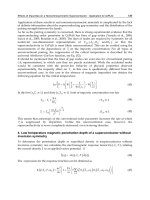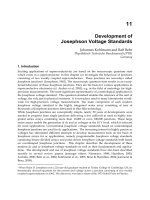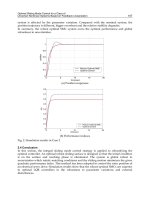FUZZY INFERENCE SYSTEM – THEORY AND APPLICATIONS doc
Bạn đang xem bản rút gọn của tài liệu. Xem và tải ngay bản đầy đủ của tài liệu tại đây (14.03 MB, 518 trang )
FUZZY INFERENCE
SYSTEM –
THEORY AND
APPLICATIONS
Edited by Mohammad Fazle Azeem
Fuzzy Inference System – Theory and Applications
Edited by Mohammad Fazle Azeem
Published by InTech
Janeza Trdine 9, 51000 Rijeka, Croatia
Copyright © 2012 InTech
All chapters are Open Access distributed under the Creative Commons Attribution 3.0
license, which allows users to download, copy and build upon published articles even for
commercial purposes, as long as the author and publisher are properly credited, which
ensures maximum dissemination and a wider impact of our publications. After this work
has been published by InTech, authors have the right to republish it, in whole or part, in
any publication of which they are the author, and to make other personal use of the
work. Any republication, referencing or personal use of the work must explicitly identify
the original source.
As for readers, this license allows users to download, copy and build upon published
chapters even for commercial purposes, as long as the author and publisher are properly
credited, which ensures maximum dissemination and a wider impact of our publications.
Notice
Statements and opinions expressed in the chapters are these of the individual contributors
and not necessarily those of the editors or publisher. No responsibility is accepted for the
accuracy of information contained in the published chapters. The publisher assumes no
responsibility for any damage or injury to persons or property arising out of the use of any
materials, instructions, methods or ideas contained in the book.
Publishing Process Manager Bojan Rafaj
Technical Editor Teodora Smiljanic
Cover Designer InTech Design Team
First published April, 2012
Printed in Croatia
A free online edition of this book is available at www.intechopen.com
Additional hard copies can be obtained from
Fuzzy Inference System – Theory and Applications, Edited by Mohammad Fazle Azeem
p. cm.
ISBN 978-953-51-0525-1
Contents
Preface IX
Section 1 Theory 1
Chapter 1 Fuzzy Logic, Knowledge and Natural Language 3
Gaetano Licata
Section 2 Application to Management Problems 19
Chapter 2 Applications of Fuzzy Logic in
Risk Assessment – The RA_X Case 21
Isabel L. Nunes and Mário Simões-Marques
Chapter 3 A Fuzzy Approach for Risk Analysis with Application in
Project Management 41
Sina Khanmohammadi and Javad Jassbi
Chapter 4 A Concise Fuzzy Rule Base to Reason Student Performance
Based on Rough-Fuzzy Approach 63
Norazah Yusof, Nor Bahiah Ahmad,
Mohd. Shahizan Othman and Yeap Chun Nyen
Section 3 Application to Mechanical and
Industrial Engineering Problems 83
Chapter 5 Control of Efficient Intelligent Robotic
Gripper Using Fuzzy Inference System 85
A.M. Zaki, O.A. Mahgoub, A.M. El-Shafei and A.M. Soliman
Chapter 6 Fuzzy Logic Controller for
Mechatronics and Automation 113
Muhammad Mahbubur Rashid and Mohamed Azlan Hussain
Chapter 7 Fuzzy Inference Systems Applied to the Analysis of
Vibrations in Electrical Machines 135
Fredy Sanz, Juan Ramírez and Rosa Correa
VI Contents
Chapter 8 The Hybrid Intelligent Method Based on Fuzzy Inference
System and Its Application to Fault Diagnosis 153
Yaguo Lei
Chapter 9 Some Studies on Noise and Its Effects on
Industrial/Cognitive Task Performance and Modeling 171
Ahmed Hameed Kaleel and Zulquernain Mallick
Chapter 10 Fuzzy Inference System for Data Processing in
Industrial Applications 215
Silvia Cateni and Valentina Colla
Section 4 Application to Image Processing and
Cognition Problems 241
Chapter 11 Fuzzy Inference Systems Applied to
Image Classification in the Industrial Field 243
Silvia Cateni, Valentina Colla, Marco Vannucci and Alice Borselli
Chapter 12 Edge Detection Based on Fuzzy Logic and
Expert System 271
Shuliang Sun, Chenglian Liu, Sisheng Chen
Chapter 13 Type-2 Fuzzy Logic for Edge Detection of
Gray Scale Images 279
Abdullah Gubbi and Mohammad Fazle Azeem
Chapter 14 Neuro-Fuzzy Prediction for Brain-Computer
Interface Applications 299
Wei-Yen Hsu
Section 5 Application to Power System Engineering Problems 313
Chapter 15 Fault Diagnosis in Power Distribution Network Using
Adaptive Neuro-Fuzzy Inference System (ANFIS) 315
Rasli, Hussain and Fauzi
Chapter 16 A Multi Adaptive Neuro Fuzzy Inference System for Short
Term Load Forecasting by Using Previous Day Features 337
Zohreh Souzanchi Kashani
Chapter 17 Fuzzy Inference System in Energy Demand Prediction 355
Thair Mahmoud, Daryoush Habibi,
Octavian Bass and Stefan Lachowics
Section 6 Application to System Modeling and Control Problems 377
Chapter 18 Control Application Using Fuzzy Logic:
Design of a Fuzzy Temperature Controller 379
R.M. Aguilar, V. Muñoz and Y. Callero
Contents VII
Chapter 19 An Evolutionary Fuzzy Hybrid System for
Educational Purposes 397
Ahmed Ali Abadalla Esmin, Marcos Alberto de Carvalho,
Carlos Henrique Valério de Moraes and Germano Lambert-Torres
Chapter 20 System Identification Using Fuzzy Cerebellar Model
Articulation Controllers 421
Cheng-Jian Lin and Chun-Cheng Peng
Section 7 Application to Civil Engineering Problems 443
Chapter 21 Fuzzy Inference System as a Tool for Management of
Concrete Bridges 445
Amir Tarighat
Chapter 22 Neural Network and Adaptive Neuro-Fuzzy Inference System
Applied to Civil Engineering Problems 471
Mohammed A. Mashrei
Preface
Evolution of global technologies has prompted increasing complexity of applications
developed in both, the industry and the scientific research fields. These complexities
are generally attributed to nonlinearities, poorly defined dynamics and absence of
apriori information about the systems. Imprecision, uncertainties and vagueness in
information about the system are also playing vital roles in enhancing the complexity
of application. During the last five decades researchers had concentrated their efforts
on providing simple and easy algorithms using different methodologies to cope
with the increasing complexity of the system. The concept of fuzzy sets had been
proposed in 1965 to address the issues of application complexities arising due to
nonlinearities, poorly defined dynamics, absence of apriori information, imprecision,
uncertainties and vague description of the system. After the proposition of fuzzy set
theory, this field has witnessed an explosion of its application in diverse multi-
discipline areas like engineering, medicine, management, behavioral science etc. The
application of fuzzy sets has widen the horizon of technologies, such as fuzzification
of pixel intensity values and fuzzy clustering on image processing, fuzzy clustering
on classification, decision making, identification and fault detection, fuzzy
controllers to map expert knowledge into control systems, fuzzy modeling
combining expert knowledge, fuzzy optimization to solve design problems etc. A
very interesting characteristic of the fuzzy systems is their capability to handle
numeric and linguistic information in the same framework. This characteristic made
these systems very useful to handle expert tasks. Making use of these characteristic
fuzzy systems are applied to artificial intelligence for representing the knowledge of
experts or acquired through learning process. Additionally, fuzzy systems provide a
rich and robust method of building systems that include multiple conflicting,
cooperating, and collaborating knowledge.
While several books are available today that address the mathematical and
philosophical foundations specific to a particular application of fuzzy logic, none,
unfortunately, provides the new practitioner, with capabilities and practical
information about diverse inter-disciplinary fuzzy system applications. This book is an
attempt to accrue the researches performed by the prominent researchers,
geographically scattered on the globe, on diverse inter disciplinary field of engineering
and management using Fuzzy Inference System (FIS). The book is spread over twenty
two chapters carved up in seven sections covering a wide range of applications.
X Preface
Section I, consists of single chapter that caters theoretical aspects of FIS. Chapter 1
deals with an introductive study about Fuzzy Logic, its differences with the other
many-valued calculi and relationships with the complex sciences.
Section II deals FIS applications to management related problems by enveloping
chapters 2 to 4. Chapter 2 describes the main features a fuzzy expert system for
supporting risk management activities termed as RA_X FMADM (Fuzzy Multiple
Attribute Decision Making) model. The support of a proactive risk management is
achieved by assessing potential factors that contribute for occupational accident
occurrence and by guiding on the adoption of safety measures. In its current stage a
prototype was implemented for test and validation purposes. Chapter 3 introduces a
new fuzzy approach to perform a more applicable risk analysis in real world
applications. The introduced method is applied to two different problems. The first
application is to determine the multi-purpose criticalities of activities. Whereas, second
application deal with simultaneous task scheduling and path planning of rescue
robots. Chapter 4 explores the potentials of the hybrid approach with the FIS to handle
uncertainties in the decision making obtained from the human experts. To reduce the
size of complete fuzzy rule base, because of large number of fuzzy term sets and
antecedents, a rough–fuzzy approach is adopted in this chapter to form a concise
fuzzy rule base with an application to reason the student performance.
Section III accumulates chapters 5 to 10 to commemorate FIS application to mechanical
and industrial engineering problems. Chapter 5 presents Adaptive Neuro-Fuzzy
Inference System (ANFIS) based modeling and various grip force control schemes of
an intelligent robotic gripper. These schemes have been tested using simulation
studies and obtained results were compared. Chapter 6 accommodates various fuzzy
logic control schemes for mechatronics and automation problem like quarter car
suspension system, rotary crane system automation, point to point position control,
mobile autonomous robot system. Chapter 7 describes a FIS based method for the
analysis of vibrations in electric machines. Chapter 8 proposes a hybrid intelligent
method based on FIS to diagnose incipient and compound faults of large-scale and
complex mechanical equipments like rotating machinery. Chapter 9 suggests studies
on noise and its effects on industrial cognitive task performance by developing a
neuro-fuzzy model for the prediction of cognitive task efficiency as a function of noise
level, cognitive task type and age. Chapter 10 presents practical applications of FIS
based data processing for detection of rare data in industrial applications that are
capable to outperform the widely adopted traditional methods.
Section IV encompasses chapters 11 to 14 and elaborates FIS application to image
processing and cognition problems. Chapter 11 describes application of FIS to image
classification in the industrial field through several examples to demonstrate
applicability of the FISs in industrial field because of their flexibility and the
simplicity. Chapter 12 explores the superiority of FIS over the Sobel and Laplacian-of-
Gaussian (LoG) operators for edge detection on some gray images. Chapter 13
presents Type-2 FIS for edge detection of gray scale images and compares the result
with Type-1 FIS and magnitude gradient methods. Chapter 14 proposes a robust
Preface XI
analysis system embedding neuron-fuzzy prediction scheme together with support
vector machine in feature extraction for brain-computer interface (BCI) application.
Section V composed of chapters 15 to 17 to describe FIS application to power system
engineering problem. Chapter 15 proposes a novel ANFIS based method for
identifying various fault types, fault location and power restoration plan in power
distribution network and evaluates the performance of proposed approach on a 47
buses practical system. Chapter 16 investigates the use of multi ANFIS to study the
design of Short-Term Load Forecasting (STLF) systems for the east of Iran. The results
show that temperature and the features of 2, 7 and 14 day ago have an important role
in load forecast. Chapter 17 analyses the use of FIS in modeling the energy demand,
improving the prediction performance and adapting the prediction to the real time
effects in a specific electric network after analyzing its demand characteristics.
Section VI constitutes chapters 18 to 20 for highlighting the FIS application to system
modeling and control problems. Chapter 18 explains the three-step structure designing
of fuzzy knowledge based controllers, i.e., fuzzification, inference and defuzzification
using a trivial, academic example involving temperature control. Chapter 19 presents
an evolutionary fuzzy hybrid system for control application by proposing the
strategies for membership function generation using three different evolutionary
algorithms namely modified genetic algorithms (MGA), particle swarm optimization
(PSO) and hybrid particle swarm optimization (HPSO). Performance of these three
different evolutionary algorithms are evaluated and compared. Chapter 20 proposes
self-constructing Fuzzy Cerebellar Model Articulation Controllers (SC-FCMAC) and
parametric FCMAC (P-FCMAC) as improvements in FCMAC, which demonstrates
state-of-the art in the field of fuzzy inference systems for system modeling and control.
Section VII accommodates chapters 21 and 22 as FIS application to civil engineering
problem. Chapter 21 proposes FIS based Bridge Management System (BMS)
comprised of a Diagnosis Synthesis (DIASYN) tool that is a fuzzy rule-based inference
system for bridge damage diagnosis and prediction, an adaptive neuro-fuzzy
inference system for bridge risk assessment, a neuro-fuzzy hybrid system for condition
state evaluation of existing reinforced concrete bridges, a fuzzy concrete bridge deck
condition rating method and a two stage method for structural damage identification
using hybrid of ANFIS and practice swarm optimization (PSO). Chapter 22 propounds
ANFIS and Artificial Neural Network (ANN) models for prediction of shear strength
of ferro-cement members and concrete beams reinforced with fiber reinforced polymer
(FRP) bars. The results of these models have been compared with experimental and
available methods results. The comparison shows that ANFIS and ANN have the
ability to predict the shear strength of ferro-cement members and the shear strength of
concrete beams reinforced with FRP with a high degree of accuracy.
Professor (Dr.) Mohammad Fazle Azeem,
Department of Electronics and Communication Engineering,
PA College of Engineering,
India









